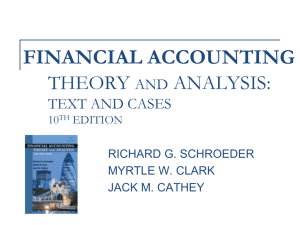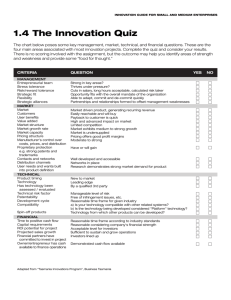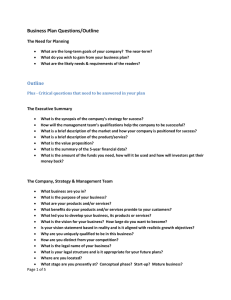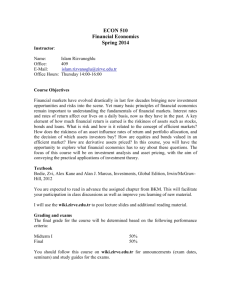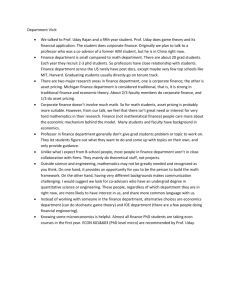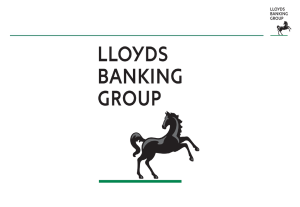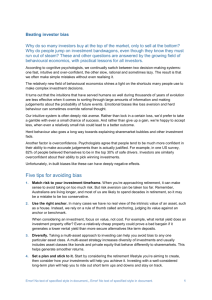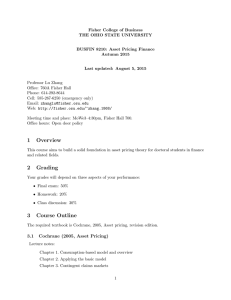Workshop Intro Slides
advertisement
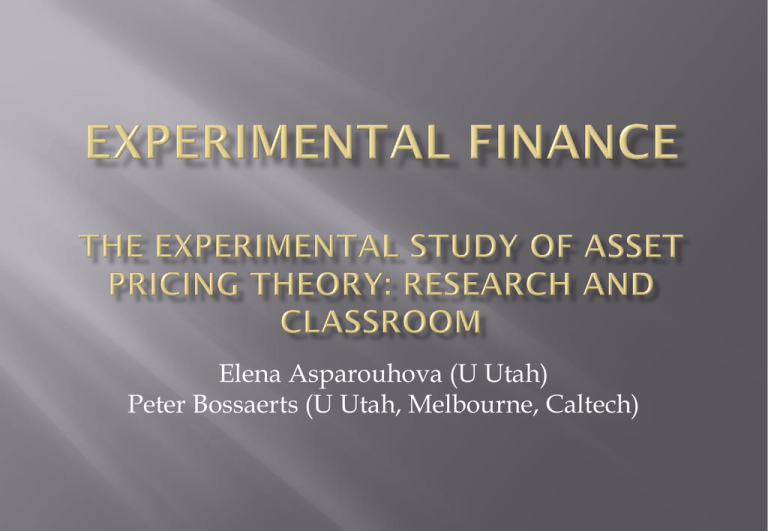
Elena Asparouhova (U Utah) Peter Bossaerts (U Utah, Melbourne, Caltech) 1. 2. 3. What we do Why experiments in finance? How do you run markets in a controlled setting? 2 We study financial decision making, all the way from the level of markets (“asset pricing”) down to the individual (“behavioral finance”). We don’t just want to describe; we want to understand! We’re not satisfied with the natural philosophy attitude in economics (using formal arguments to rationalize historical data) We want to apply the scientific method … which inevitably means: the use of experiments Observe humans make (financial) decisions and interact in a controlled setting 3 4 But isn’t the proposition (that two objects of different weights fall at same speed) obviously wrong? Leaves and branches do not fall at the same speed So, what does the lab experiment really mean? We will see this in economics/finance/psychology “The CAPM has been rejected in the real world, so why test it in the lab?!” 5 … is the “canonical” model of asset pricing Explains how and why average (expected) returns on risky securities differ Or equivalently, why two securities with the same expected payoffs or even the same payoff distribution may sell for different prices 6 “Finance is in no need of experiments. We have lots of data.” Editor, Econometrica ‘Real-world markets (and their inhabitants) are “bigger” and “more complex” than anything one can study in the laboratory’ Too complex? That is precisely their problem… They cannot be described in terms of simple equations; so you need control, i.e., laboratory study Too big! Sure, but we have to start somewhere. Without experimentation, we are "likely to go completely astray into imaginary conjecture” [Hannes Alfven, Nobel Laureate in (Astro)Physics] And whether “real” traders are “bigger” than our subjects remains to be proven (besides, we DO use “real” traders at times) 7 (Many) economists argue that the way to understand financial markets is to extrapolate from the individual (decision making). Really? Economists argue that excess volatility in stock markets is caused by institutions (e.g., leverage), policy ambiguity (i.e., government), potential for catastrophic events, etc. Why can’t it be the effect of human market interaction itself? Do we need governments (so we can blame them)? Why do we outlaw over-the-counter (“dark”) markets (Dodd-Frank, MiFID 2)? Because they seem to make no sense? Or because the “First Welfare Theorem” requires everyone to be trading at the same price? Why is policy and regulation in finance not based on controlled experimentation (wind tunnels, clinical trials, field experiments)? 8 Excess volatility: the fact that fundamentals (dividends, aggregate consumption, etc.) explain only a small fraction of changes in prices First welfare theorem: The walrasian (competitive) equilibrium leads ensures optimal allocations 9 Finance theory in general and asset pricing in particular is highly stylized It ignores many aspects of the “real world” So, it controls for confounding factors And that is precisely what experiments are about Asset pricing theory is ready for the lab! 10 You learn A LOT about the theory when trying to design an experiment! E.g.: CAPM: Do investors need to know the market portfolio? Recent asset pricing theory with disagreeing investors: Do investors need to know what other investors think? Lucas: How do we generate a representative agent? Insurance/loan markets (Rothschild-Stiglitz): what does it mean when “equilibrium does not exist”? Feynman: “What I cannot create I do not understand” 11 Need software… flex-e-markets Keeps track of negotiation and trading (People used to do things manually!) Allocate purposely designed securities Let people trade See what happens At the market level At the individual level 12 Go to http://uleef.business.utah.edu/flexemarkets Log on as: Any ID between 1 and 30 Password = “password” Marketplace = Brissy-Div-1 and then Brissy Div-2 13



